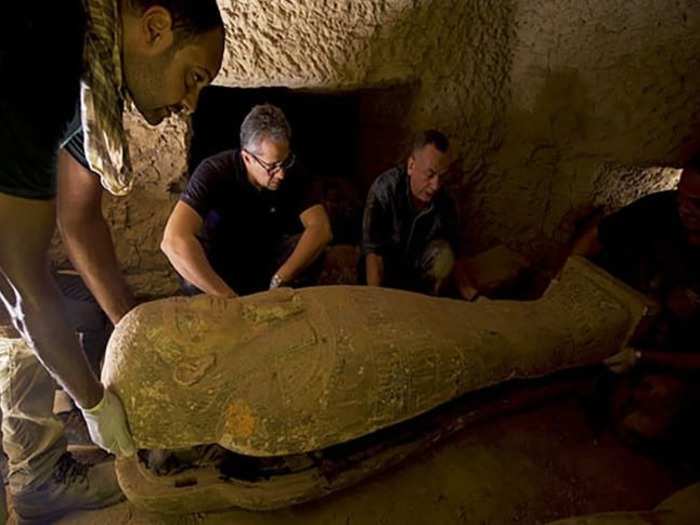
A 2500-year-old coffin discovered in a burial shaft in the desert near the Saqqara necropolis in Egypt. The image was released September 19, 2020 by the Egyptian Ministry of Antiquities.The Egyptian Ministry of Antiquities/Handout via Reuters
More than two millennia ago, 27 Egyptians were laid to rest in Saqqara, an ancient city of the dead. Their organs were removed, and their bodies wrapped in linens. Priests placed them inside wooden boxes adorned with hieroglyphics.
The mummies stayed buried in those sarcophagi for 2,500 years — until their recent discovery by Egyptian archaeologists.
The finding is one of Egypt's largest in over a century.
It happened in two parts: In early September, Egypt's Ministry of Tourism and Antiquities announced more than a dozen coffins had been found in a burial shaft under the ancient city of Saqqara. Then two weeks later, the shaft yielded a second set of sarcophagi.
"Initial studies indicate that these coffins are completely closed and haven't been opened since they were buried," the ministry said in a Facebook post on Sunday.
The photos below show how archaeologists found the sarcophagi,and other mummies buried beneath Saqqara.

Khaled El-Enany, Egypt's minister of tourism and antiquities, said on Twitter that finding the coffin cache was "an indescribable feeling."
The shaft had three offshoots branching away from it, so El-Enany predicted at the time that more undiscovered were likely still buried in the shaft.

That brought the total to 27.
In a statement on Facebook, Egypt's Ministry of Tourism and Antiquities noted that this finding is "the largest number of coffins with one burial" discovered since a group of 30 coffins were unearthed at Al-Assasif cemetery in Luxor last year.

The ministry has not yet opened them.

The coffins were found stacked on top of each other in the shaft.

They also uncovered a wooden obelisk just over a foot tall that's adorned with paintings of Egyptian gods and goddesses, CNN reported.

Saqqara was the necropolis, or city of the dead, for the ancient capital of Memphis. Its name likely derives from Sokar, the Memphite god of the dead.

The architect Imhotep built the pyramid to house the remains of King Djoser, an ancient Egyptian pharaoh from the Third Dynasty.
It was the first building ever made of stone, and it paved the way for other pyramids, including the Great Pyramid of Giza.

The Ministry of Tourism and Antiquities announced in 2018 that archaeologists had discovered a 4,400-year-old tomb in Saqqara. It belonged to a royal purification priest who served during the reign of King Nefer-Ir-Ka-Re.

They found two rare mummified lion cubs, as well as mummified birds, crocodiles, cats, cobras, and an enormous mummified scarab beetle.

The cubs were only eight months old when they were mummified. Other mummified wildcats were found alongside the two lions.
!["This is the first time [a] complete mummy of a lion or lion cub" has been found in Egypt, Mostafa Waziri, the secretary-general of Egypt's Supreme Council of Antiquities, said in a press conference. "This is the first time [a] complete mummy of a lion or lion cub" has been found in Egypt, Mostafa Waziri, the secretary-general of Egypt's Supreme Council of Antiquities, said in a press conference.](/thumb/msid-60085318,width-700,height-525/60085318.jpg)
Ancient Egyptians mummified and buried millions of animals, often treating creatures like hawks, cats, and crocodiles with the same reverence that they would a human corpse.
The Egyptians believed animals were reincarnations of gods, so they honored them by mummifying the creatures and worshipping these animals in temples. Mummified animals could also serve as offerings to those gods.
 Should you be worried about the potential side-effects of the Covishield vaccine?
Should you be worried about the potential side-effects of the Covishield vaccine?
 India T20 World Cup squad: KulCha back on menu, KL Rahul dropped
India T20 World Cup squad: KulCha back on menu, KL Rahul dropped
 Sales of homes priced over ₹4 crore rise 10% in Jan-Mar in top 7 cities: CBRE
Sales of homes priced over ₹4 crore rise 10% in Jan-Mar in top 7 cities: CBRE

Copyright © 2024. Times Internet Limited. All rights reserved.For reprint rights. Times Syndication Service.